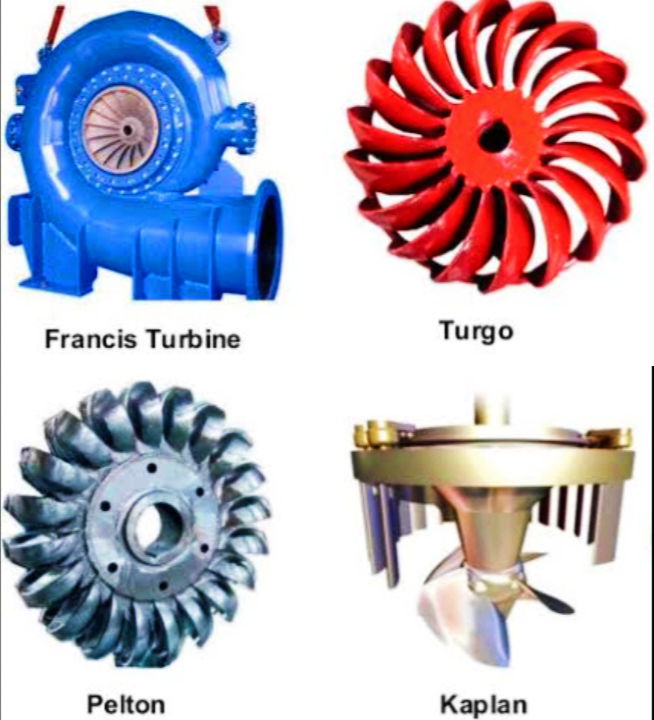
Hydropower Plants are essential for generation of renewable energy by harnessing the energy of moving water. One of the most important component of Hydropower Plant is the turbine. The turbine converts the energy of moving / flowing water into mechanical energy, later which is converted into electrical energy by generator. The choice of turbine depends on multiple factors, such as net head, flow rate of water and geological conditions of the site. In this article we will explore different types of turbines commonly used in Hydropower Plants, specification of each turbine, output power range and geological conditions.
1. Pelton Turbine: Pelton Turbine is a type of impulse turbine used for high head and low water flow applications. This turbine is more suitable for the plants where water reservoir have significant height above the turbine.
- Specifications: The Pelton turbine operates on the principle of impulse, in which the water jet strikes the turbine’s blades or buckets, cause turbine to spin. It is generally used for sites with a high net head and relatively low flow rates. It consists of multiple buckets mounted on a runner, with each bucket receiving a water jet at a high velocity.
- Output Power Range: The output of a Pelton turbine typically ranges from a few kilowatts to 200 MW, depending on the water flow and head conditions.
- Net Head Range: Pelton turbines are ideal for high-head conditions, typically ranging from 100 meters to over 2,000 meters.
- Geological Conditions: Pelton turbines are best suited for mountainous or hilly terrain, where water can be channeled from higher elevations to the turbine.
2. Francis Turbine: The Francis turbine is a mixed-flow turbine, suitable for medium-head applications. It’s one of the most commonly used turbines for hydropower plants due to its versatility in handling both high and low flow conditions.
- Specifications: The Francis turbine has a spiral casing that guides water to the runner. The water enters the turbine radially and exits axially, which allows it to efficiently handle a wide range of flow rates. It operates on both impulse and reaction forces, making it suitable for applications where water flow fluctuates.
- Output Power Range: Francis turbines are commonly used for medium to large hydropower plants and can range from 1 MW to over 700 MW, depending on the head and flow conditions.
- Net Head Range: They are suitable for a net head range between 20 meters and 700 meters.
- Geological Conditions: Francis turbines are typically used in regions with moderate to high net heads and can be installed in both riverbed and dam-based hydropower plants. They are adaptable to various geological conditions.
3. Kaplan Turbine The Kaplan turbine is a propeller-type reaction turbine that is widely used in low-head, high-flow hydropower plants. Its design allows it to be extremely efficient at sites with abundant water flow but low water head.
- Specifications: The Kaplan turbine features adjustable blades that can be changed to suit different flow conditions. It is particularly efficient at sites where water flow varies significantly. Water enters axially and exits radially, and the blades can be adjusted to optimize the turbine’s performance for varying conditions.
- Output Power Range: Kaplan turbines are typically used for plants with outputs ranging from 10 MW to 300 MW.
- Net Head: These turbines are suitable for low-head conditions, typically between 2 meters and 30 meters.
- Geological Conditions: Kaplan turbines are ideal for river-based plants or locations with low-altitude sites where there is a steady, high flow of water. They are commonly used in floodplains or coastal regions.
4. Turgo Turbine The Turgo turbine is a variant of the impulse turbine, known for its ability to handle higher flow rates than a Pelton turbine while still operating efficiently at high-head sites. It combines elements of both the Pelton and Francis turbines.
- Specifications: The Turgo turbine uses a single water jet to strike the turbine blades, which are mounted at an angle to the flow. Like the Pelton turbine, the Turgo is an impulse turbine, but it can handle a higher range of flows than a Pelton turbine.
- Output Power Range: The output of a Turgo turbine typically ranges from 1 to 15 MW.
- Net Head Range: The ideal net head range for Turgo turbines is between 30 meters and 500 meters.
- Geological Conditions: Turgo turbines are well-suited for mountainous or rugged terrain, where high heads and variable water flows are present. These turbines are commonly used in sites with steep slopes and strong water flows.
5. Bulb Turbine Bulb turbines are another type of reaction turbine, similar to the Kaplan turbine, but specifically designed for very low-head, high-flow conditions. They are typically used in run-of-river hydropower plants or locations where water levels fluctuate slightly.
- Specifications: Bulb turbines are characterized by a cylindrical casing that contains the runner, which is located in the middle of the water flow. This configuration allows the turbine to be placed underwater and is ideal for low-head installations.
- Output Power Range: Bulb turbines typically have outputs ranging from 10 to 100 MW.
- Net Head Range: These turbines work best with very low heads, typically between 1 meter and 15 meters.
- Geological Conditions: The bulb turbine is best suited for sites with flat terrain, such as riverbeds, where water flow is steady but the available head is limited.
Conclusion Choosing the right turbine for a hydropower plant is crucial for maximizing energy efficiency and ensuring the plant can operate effectively in varying water conditions. Whether you’re looking to harness water from a high-altitude mountain stream with a Pelton turbine or from a low-flow river with a Kaplan or Bulb turbine, the key lies in selecting the turbine that best matches the site’s net head, flow rate, and geological conditions. By understanding the specifications, output ranges, and optimal conditions for each turbine type, you can make a more informed decision and contribute to the success of your hydropower project.